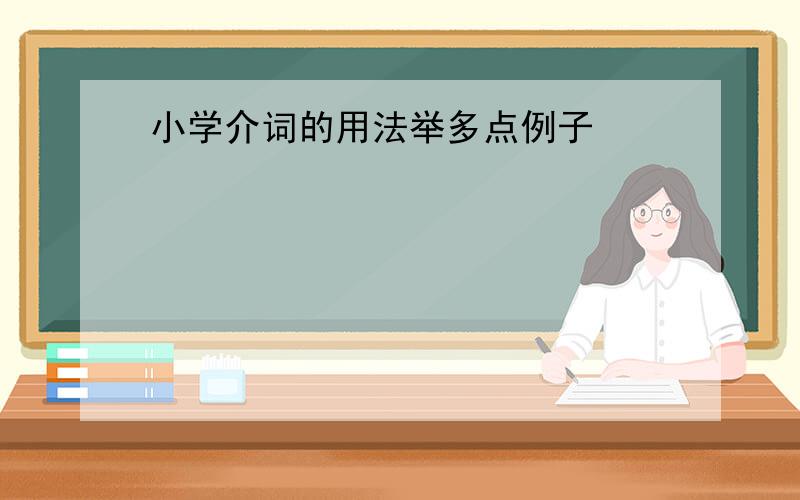小学介词的用法举多点例子
来源:学生作业帮 编辑:灵鹊做题网作业帮 分类:英语作业 时间:2024/04/27 03:34:25
小学介词的用法
举多点例子
举多点例子

1、小学英语介词at,in与on在时间方面的用法 at表示时间的一点;in表示一个时期;on表示特殊日子.如: He goes to school at seven o’clock in the morning. 他早晨七点上学. Can you finish the work in two days. 你能在两天内完成这个工作吗? Linda was born on the second of May. 琳达五月二日出生. 1>. at后常接几点几分,天明,中午,日出,日落,开始等.如: at five o’clock (五点),at down (黎明),at daybreak (天亮),at sunrise (日出),at noon (中午),at sunset (日落),at midnight (半夜),at the beginning of the month (月初), at that time (那时),at that moment (那会儿),at this time of day (在一天的这个时候). 2>. in后常接年,月,日期,上午,下午,晚上,白天,季节,世纪等.如: in 2006(2006年),in May,2004 (2004年五月),in the morning (早晨/上午),in the afternoon (下午),in the evening (晚上),in the night (夜晚),in the daytime (白天),in the 21st century (21世纪),in three days (weeks/month)三天(周/个月),in a week (一周),in spring (春季). 3>. on后常接某日,星期几,某日或某周日的朝夕,节日等.如: on Sunday (星期日),on a warm morning in April (四月的一个温暖的上午),on a December night (12月的一个夜晚),on that afternoon (那天下午),on the following night (下一个晚上),on Christmas afternoon (圣诞节下午),on October 1,1949 (1949年10月1日),on New Year’s Day (新年),on New Year’s Eve (除夕),on the morning of the 15th (15日的早上)等. 2、 巧记形容词的排列顺序 当两个以上形容词修饰一个名词,形容词该如何排 列?为什么不能说a black new pen,而是说成a new black pen? 这里面有无规则可循? 如果你记住opshacom这个为帮助记忆而杜撰的词, 就能掌握英语中形容词排列的顺序. opshacom中p代表opinion,指表示人们观点的形容 词,如beautiful,horrible,lovely,nice等; sh代表shape,指表示形状的形容词,如long,short,round, narrow等; a代表age,指表示年龄、时代的形容词,如old,new,young等; c代表colour,指表示颜色的形容词,如red,black, orange等; o代表origin,指表示国籍、地区的形容词,如british,canadian,german等; m代表material,指表示材料的形容词,如plastic,metal,aluminium等. 英语中这六类形容词连用时就按上述先后顺序排列, 如a nice long new black british plastic pen 当然,实际语言使用中不可能出现这么多形容词连 用的情况. 请根据形容词排列规则完成以下练习: 1>.she has a ___ jacket.(leather,brown,beautiful) 2>.he has a ___ car. (american,long,red) 3>.they live in a ___ house. (old,beautiful) 4>.we have a ___ table. (antique,small,wooden) 5>.he has a ___ jumper. (woollen, lovely, red) 6>.she has a ___ ring. (diamond,new,fabulous) 7>.it was a ___ song.(french,old, lovely) 8>.he owns a ___ dog.(black,horrible,big) 9>.she bought a ___ scarf.(gorgeous,silk,pink) 一、一般现在时主要用于: 1 、表示经常性或习惯性动作. e.g. It seldom snows here. 2 、表示现在的特征或状态. e.g. He is always ready to help others. 3 、普遍真理. e.g. Action speaks louder than words. 4 、剧情图片介绍,背景说明,动作解说. e.g. (Tom enters the room_and_sits at the table) Doctor : What`s your trouble, young man? Tom : I`ve caught a cold, doctor. 5 、时间、条件、让步、方式状语从句表将要发生的动作时. e.g. Tomorrow we shall go for an outing unless it rains. 与这种时态连用的时间状语常有: always, often, never, seldom, usually, once, a week, now 等. 二、一般过去时主要用于: 1 、表示过去某个时间发生的动作或情况(包括习惯性的动作或状态) e.g. When did you read the novel? She often came to help us in those days. 2 、谈到过去的情况时 e.g. I didn`t know you were so busy. 3 、谈到已死人的情况时 e.g. Lei Feng was a great communist fighter. 与这个时态连用的时间状语常有: yesterday, last night, the other day, two months ago, in 1985, then, just now, when, after, as soon as 引导的时间状语从句,表示主句动作开始的时间. 三、现在完成时主要用于: 1 、表示到现在为止这一时期中发生的动作或情况,即多次动作的总和. e.g. We have learnt four English songs this month. How many times have you read the novel? For many days we haven`t seen each other. 2 、表示对现在有影响的某一已发生的动作. e.g. The delegation has left 代表团已经走了(说明现在不在这里) Look, what you have done. 看你干的事. 与这一时态连用的时间状语有: already, yet, just, ever, never, by now, so far, recently, by the end of this month, since, for 短语,连词 since 引导的时间状语从句. 一般过去时与现在完成时的区别: 一般过去时:重在说明动作在过去发生时的具体情况(时间、地点、方式、对象、细节等). 现在完成时:只提起已发生的动作(事实)及其影响,不说明动作发生时的具体情况. cf. Have you had your lunch? What did you have for lunch? I have ever been to the Great Wall,_and_I went there last summer with my father. 注:现在完成时表达的动作常具有反复性,故下面一句是错的: Have you seen the six thirty`s news program? 应改为: Did you see the six thirty`s news program? 四、现在完成进行时主要用于:表示过去开始的某一动作一直持续到现在,以至延伸到将来,它强调动作延续时间之长久. e.g. I`ve been writing an article. 我一直在写一篇文章.(还在写) cf. I`ve written an article. 我写了一篇文章.(已写完) It has been raining these days. 这些天一直在下雨.
小学介词的用法举多点例子
小学副词的用法并说说,副词后面可以加什么词?要举多点例子.
外表不重要的例子大家举多点例子啊
except for 中except的词性是介词吗?for也是介词两个介词连用属于什么用法?请举一些其他相同的例子!
冠词的用法,并且举几个例子
with表伴随的用法with+sthwith+sth+adjwith+sth+介词短语 然后举点例子吗?
高一定语从句里的例如WHICH和介词加WHICH用法到底有什么区别?举几个例子.
主谓宾是什么?举多点例子看看.
生活中有哪些磁性材料举多点例子啊给例子最多的那个分
介词后what引导的宾语从句例子举几个,
小学介词用法
请举一个简单的例子说明ZOrder的用法,